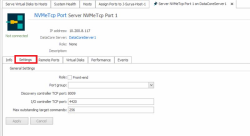Modifying NVMeTCP Port Settings
Explore this Page
- Overview
- NVMeTCP Port Settings
- Changing the I/O Controller TCP Port Number
- Changing the Maximum Outstanding Target Commands
Overview
This page explains how to modify NVMeTCP server port settings such as the role, port group, TCP port numbers, and maximum outstanding target commands. These changes can affect performance and require the port to be re-initialized. Basic NVMeTCP port settings can be modified in the Settings tab of the port details page.
NVMeTCP Port Settings
- In the Server Group > Sever Ports list, click the NVMeTCP server port and select the Settings tab.
- Under the General Settings section, configure the following options:
- Role: Select the Front-end checkbox to enable this port for NVMeoF host communication.
- Port Group: (Optional) Assign a port group if configured.
- Discovery Controller TCP Port: Default is 8009. This port is used by hosts to discover available NVMe namespaces and cannot be modified.
- I/O Controller TCP Port: Default is 4420. Used for NVMeTCP I/O traffic once the host connects to the subsystem.
- Maximum Outstanding Target Commands: Defines the maximum number of NVMeTCP commands that can be queued to the target at one time. The default is 256, and the range is 256–65535.
Changing the I/O Controller TCP Port Number
- In the I/O Controller TCP port box, enter the new port number.
- Click Apply, and then click Yes when prompted to re-initialize the port.
Changing the Maximum Outstanding Target Commands
This setting limits the number of NVMeTCP target commands that are active at the same time. The default setting is 256 maximum outstanding target commands; the range is 256 to 65535 outstanding commands. When this setting is changed, the port will be reinitialized and during that time traffic on the port will be suspended.
If one initiator is logged in, it can queue up to the full number of commands.
If multiple initiators are logged in, the maximum is divided dynamically among them. For example, with 256 set and two initiators logged in, each can queue up to 128 commands.
The maximum number of initiators per target port is 128; this setting cannot be changed.
To change the setting:
- In the Settings tab of the NVMeTCP server port details page, enter the new value in Maximum Outstanding Target Commands.
- Click Apply, and then click Yes to confirm re-initialization.
- Changing NVMeTCP port settings causes the port to be re-initialized, temporarily suspending traffic on that port.
- NVMeTCP ports do not use iSCSI-specific settings such as IQNs, CHAP authentication, or TCP congestion provider options.
Learn More
